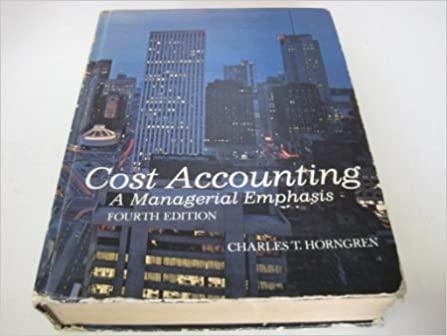Comprehensive Study of Inventory Planning and Control The Ward Company is trying to obtain better means of
Question:
Comprehensive Study of Inventory Planning and Control ‘The Ward Company is trying to obtain better means of controlling inventory levels and attendant costs for an expensive part that they have been using for some time. Studies of cost behavior patterns reveal the following information:
Variable costs of placing and following up purchase orders (stationery, postage, telephone, etc.) total $3 per order. Other clerical costs, such as salaries and related office-equipment expenses, have a step cost behavior as follows:
For every additional 200 orders processed per week, there is a $70 increase in purchasing costs, a $60 increase in accounting costs, and an $80 increase in receiving costs.
Insurance and taxes on inventory are 4 percent of average inventory value per year.
The factory is rented at a cost of $60,000 per year. It contains 100,000 square feet of floor space, of which 3,000 square feet are reserved for storing this item. Excess storage space is available in the neighborhood at 75¢ per square foot per year. Extra handling costs for using excess storage space will be 24%¢
per inventory unit in excess storage space per year. The article requires storage space, allowing for aisles, of three square feet each and can be stacked six units high.
Breakage, obsolescence, and deterioration amount to about 2 percent of average inventory per year.
The company’s average before-tax cost of capital is 10 percent per annum.
The company uses this rate for inventory-investment decisions.
The Ward Company works 52 weeks a year, 5 days per week. It uses an average of 100 subassemblies per workday, but usage fluctuates from as low as 50 to as high as 150 per day. Many suppliers are available; but regardless of the source of supply and the size of the order, it will take two weeks from the time a purchase order is placed until delivery. Top management wants to keep an ordinary minimum stock of 1,500 units. ee ts The purchasing agent is anxious to take advantage of savings in unit invoice and freight costs by purchasing in large quantities. Pertinent purchasing data are as follows: ;
INVOICE COST FREIGHT COST Lot Size Unit Cost Total Cost Unit Cost Total Cost 1,000 $55.00 $ 55,000.00 $5.00 $ 5,000.00 2,000 55.00 110,000.00 5.00 10,000.00 4,000 55.00 220,000.00 5.00 20,000.00 5,000 54.00 270,000.00 5.00 25,000.00 6,000 54.00 324,000.00 4.40 26,400.00 8,000 54.00 432,000.00 4.00 32,000.00 10,000 54.00 540,000.00 3.80 38,000.00 13,000 53.50 695,500.00 3.80 49,400.00 26,000 52.00 1,352,000.00 3.50 91,000.00 Special note Assume that the base stock is already on hand and is therefore irrelevant. The average inventory that is relevant is exclusive of the base. Assume, too, that the maximum inventory to be computed for commitments to excess storage space will be the absolute maximum, computed as follows: order point less minimum usage if
+ standard order.
What order size should the Ward Company use? Support your answer by tabular analysis of the relevant costs for each lot size given above from 1,000 to 26,000.
. What considerations other than the quantitative data may influence the decision here?
. Comment on the cost behavior patterns in the situation. Which costs appear to be the most crucial? lop5
Step by Step Answer:






